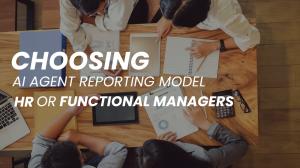Choosing an AI Agent Reporting Model: HR or Functional Managers
AI agents are the newest “team members”—but who should they report to: HR for ethics or managers for speed? The future may belong to a smart, hybrid model.
WASHINGTON, DC, UNITED STATES, November 27, 2025 /EINPresswire.com/ -- Quick Poll: Organizations are considering whether AI agents should report to HR for ethical oversight or to functional managers for operational efficiency.• HR (Ethics & Compliance First)
• Functional Managers (Speed & Expertise)
• Hybrid Model: 20%
As the EU AI Act’s 2025 implementation deadlines approach, organizations are evaluating how agentic AI may influence reporting structures. AI agents are being used for tasks such as data analysis, workflow automation, and transactional decision-making, prompting questions about appropriate governance and supervision.
Knowledge Networks, RegulatingAI, and CAIO Connect have examined this topic through podcasts, webinars, and research discussions focused on emerging AI operating models. Drawing on analyses from sources such as McKinsey and Gartner, they outline the principal reporting options and associated considerations.
HR Reporting Model
Under this model, AI agents are placed within HR-led governance structures. HR is responsible for oversight related to employee impacts, fairness, and regulatory compliance.
Potential Advantages
• Bias and Risk Management: Centralized HR oversight may help identify and mitigate potential biases in AI outputs.
• Consistency Across Functions: HR-led governance can create uniform standards for privacy, fairness, and compliance across the organization.
• Alignment with Regulation: HR teams are often responsible for managing compliance processes that intersect with AI use, such as transparency requirements or workforce-impact assessments.
Potential Limitations
• Operational Bottlenecks: HR may not always have deep domain expertise in functional areas, which could slow iteration or limit the adaptability of agents used for specialized tasks.
Functional Manager Reporting Model
In this structure, AI agents report directly to the functional departments where they are deployed, such as sales, finance, operations, or IT.
Potential Advantages
• Domain Knowledge: Functional leaders may be better positioned to guide agents in context-specific tasks and adjust configurations quickly.
• Direct Accountability: Performance can be linked more clearly to departmental metrics and operational outcomes.
• Faster Iteration: Functional ownership may enable faster experimentation and deployment.
Potential Limitations
• Inconsistent Governance: Without a central oversight mechanism, ethical, privacy, or compliance considerations may be applied unevenly across departments.
• Risk of Misalignment: Independent development of AI practices in each function could produce conflicting standards or uncoordinated use of AI resources.
Hybrid Reporting Model
Hybrid models combine functional and HR oversight. AI agents may report operationally to functional managers while also undergoing periodic HR or central compliance review.
Characteristics of Hybrid Models
• Dual Accountability: Functional managers supervise daily operations while HR or a central governance team conducts audits or ethical assessments.
• Balanced Priorities: This model seeks to combine operational speed with standardized oversight.
• Scalability: Some organizations adopt hybrid structures to manage increasing numbers of agents without over-centralizing or decentralizing governance.
Practical Considerations for Organizations
1. Defining the Agent Lifecycle: Organizations may establish intake, validation, deployment, and monitoring stages that clarify responsibilities across HR and functional teams.
2. Establishing Metrics: Evaluation criteria may include both governance indicators (e.g., fairness, privacy compliance) and operational metrics (e.g., efficiency or accuracy improvements).
3. Running Controlled Pilots: Pilot programs can help organizations test different reporting structures before broader adoption.
4. Training and Governance: Managers and HR professionals often require training in AI fundamentals, risk identification, and governance practices to ensure effective oversight.
Conclusion
Different reporting structures offer distinct strengths and challenges. HR-led models emphasize governance and risk mitigation, functional models emphasize operational efficiency, and hybrid models attempt to balance these aims. Organizations evaluating AI agent supervision may consider factors such as regulatory requirements, internal capabilities, scale of deployment, and the complexity of the tasks being automated.
Author
Sanjay Puri
President, Knowledge Networks
Upasana Das
Knowledge Networks
email us here
Visit us on social media:
LinkedIn
Instagram
Facebook
YouTube
X
Legal Disclaimer:
EIN Presswire provides this news content "as is" without warranty of any kind. We do not accept any responsibility or liability for the accuracy, content, images, videos, licenses, completeness, legality, or reliability of the information contained in this article. If you have any complaints or copyright issues related to this article, kindly contact the author above.
